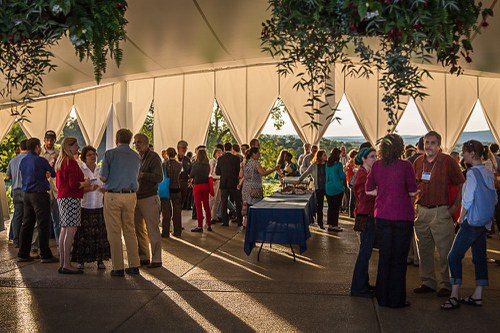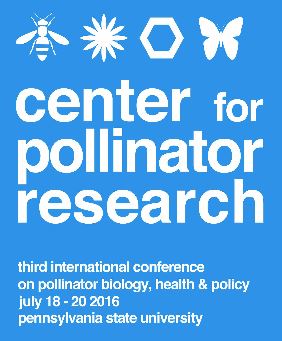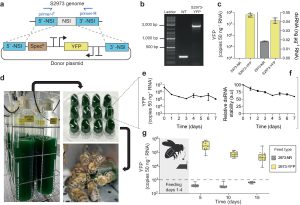2016 International Conference on Pollinator Biology, Health and Policy
Date and Location
When (Date/Time)
July 18, 2016 to July 20, 2016
Where
Penn State campus, University Park, PA
CONFERENCE INFO
A major theme of this year’s conference will be translating the results of recent research advances in the biology and health of pollinators into solutions that can be applied in the field to conserve and expand pollinator populations. The conference will cover a range of topics in pollinator research, from genomics to ecology, and their application to land use and management, breeding of managed bees, and monitoring of global pollinator populations. Recent global initiatives in policy, education, and extension will also be highlighted.
The conference plans to feature three world-renowned keynote speakers: Rachael Winfree (Rutgers University) who will discuss what pollinators can tell us about biodiversity and ecosystem services in real-world landscapes, Gene Robinson (University of Illinois), who will share insights from the application of genomics to pollinator behavior and health, and Sonny Ramaswamy (Director, USDA-NIFA) who will discuss highlights and successes of the US federal strategy to promote pollinator health.
Other confirmed speakers include Dennis vanEngelsdorp (University of Maryland), Marina Meixner (Bieneninstitut Kirchhain, Germany), Taylor Ricketts (University of Vermont), Luisa Carvalheiro (University of Brasilia, Brazil), Ed Rajotte (Penn State University), Amy Toth (Iowa State University), Guy Smagghe (Ghent University, Belgium), Lucy King (Save the Elephants), Andrew Barron (Macquarie University, Australia), Hollis Woodard (University of California, Riverside), Mark Brown (Royal Holloway University of London), Dan Cariveau (University of Minnesota), Katharina Ullman (The Xerces Society for Invertebrate Conservation), Vicki Wojcik (Pollinator Partnership), and Matthew Smart (USGS). Symposia will include invited and contributed talks and posters related to epidemiology and modeling of global pollinator populations, managing landscapes for ecosystem services, pollinator nutrition and habitat, integrated pest and pollinator management, molecular tools for managing pollinator populations, and education and outreach.
The conference will be preceded by a one-day Pollinator Conservation Short Course hosted by the Xerces Society for Invertebrate Conservation on Sunday, July 17, 2016. The Short Course will also be held at Penn State in University Park, PA and it will feature presentations on creating and protecting pollinator habitat, as well as related research of Penn State scientists. Please contact Jillian Vento for more information.
When this conference was held in 2013, it attracted over 230 participants from 15 countries, representing universities, government agencies, industry, non-profit organizations, and several stakeholder groups. For more information, you can review details about the 2013 and 2010 conferences, including an abstract book and several of the policy-related presentations.
For more information about the conference, please email Kim Swistock, or the conference organizers, Christina Grozinger (Penn State), Shelby Fleischer (Penn State), Neal Williams (UC Davis) and Rufus Isaacs (Michigan State University).
The Center for Pollinator Research at Penn State is a dynamic consortium of more than 25 faculty involved in research, education and extension efforts focused on improving pollinator health, conservation and ecosystem services. For more information on the Center, please visit our website.
For more information, please see the conference agenda, online registration and abstract submission site.
SPEAKERS, AGENDA AND POSTERS
https://custom.cvent.com/18A6750208F1461A8000EA09BA931C3A/files/e59e8f07c1fb44bea61700bb63f47ef9.pdf
DAILY UPDATES
07-18-16
Dr. Christina Grozinger, “In previous conferences we learned there are a lot of ways to kill bees.”
Sonny Ramaswamy
Director, National Institute of Food and Agriculture, Washington, DC 20250
A suite of contributors to pollinator losses: biotic and abiotic.
Path forward:
- Transformative discoveries
- 21st Century Extension
- Farming Systems
- Education
- Policies, regulation, marketing
- Human dimensions
- Communications
The Pope’s Encyclical has done much to communicate to the public the concerns of nature, science, and human education.
Dennis vanEngelsdorp
Assistant Professor, University of Maryland, Department of Entomology
Bee health appears to be a long term problem. How much disease is out there, what factors correlate with the disease, how do we stop the disease?
From the BIP management survey they learned beekeepers starting with packages suffer greater issues than those who start with nucs. They have developed best management practices, and are field-testing them now.
When we find 10 mites per sample then the pesticide exposure increases other health issues. This needs to be tested further. Mite treatment products are now showing mite resistance.
So a beekeeper can treat, but the mites are resistant.
There are some mgmt.. practices very effective one year, and not so much the next year. Local climatic issues may be affecting this as well as pesticide exposure, which all change year to year.
The international SMARTBEES project – preserving the biodiversity of honey bees in
Europe and developing sustainable strategies for the Varroa problem
Marina D. Meixner
LLH Bee Institute Kirchhain, Germany
There is an increasing awareness in many countries and regions to preserve native bees. Native bees are viewed as part of the national heritage. Locally adapted bees survive better and are more productive. Local adaptation may be essential for resistance to pests and pathogens.
14 research institutes across Europe tested bee geno-types requiring NO Varroa treatments at all on any of the test colonies. Survival trajectory showed local bees survived an average of 90 days longer in the absence of ANY Varroa treatment. Locally adapted bees are a strong solution for sustainable management.
07-19-16
Putting the international in the conference included the study and implantation of honey bees to protect crops, as well as pollinate and provide additional income for farmers. Dr. Lucy E. King, Head of Human-Elephant Co-Existence Program, Save the Elephants, Kenya and Research Associate, Department of Zoology, University of Oxford, UK, discussed The Elephants and Bees Project: Using Bees as a Natural Deterrent for Crop-Raiding Elephants
“Elephants in Kenya are not confined to national parks and reserves; hence interactions between farmers and crop-raiding elephants can pose serious social, political, economical and conservation problems.” Dr Lucy King’s research has proved that African elephants are aware about, and will actively avoid, the threat of African honey bees. She demonstrated that not only do they run away from disturbed bee sounds but her team also revealed that elephants emit a unique low frequency (infrasonic) rumble that warns other elephants in the area to retreat. These rumbles appear to be novel to the threat of bees when compared to infrasonic rumbles emitted by elephants in response to human threat. These behavioural discoveries were groundbreaking, and encouraged her to develop and test a unique application for this behaviour through the use of protective Bee-hive Fences around farmers’ fields with the aim of reducing human-elephant conflict (HEC). The Beehive Fences are not only reducing damaging crop-raids by elephants by as much as 80%, but the bees are also helping to pollinate the fields, and farmers are now harvesting valuable “Elephant-Friendly Honey” as an additional product from their land. Since starting her research in 2006, the Beehive Fence HEC mitigation concept has spread rapidly and Beehive Fences are presently up and running in test sites in Kenya, Tanzania, Uganda, Botswana, Mozambique, India and Sri Lanka and has now been incorporated into Kenya’s 2012-2021 management strategy for elephant conservation in the country.”
In her presentation at this international conference at Penn State she stated the elephants quickly learned that just a recording of “an angry bee hive” was just that, a recording. See the film of elephants departing an area, even while resting in the heat of the day, when they hear the bee sounds at this link http://elephantsandbees.com/elephant-behaviour-elephants-bees-media-library/ The elephants also can smell the honey in hives. While bee stings have no effect upon the elephant hide, bees attack the elephants eyes and mouth and trunk. In tests, whole fences were breached with fake hives only emitting “sounds” of angry bees. To truly protect farmers’ fields fully occupied bee hives are needed to make the bee hive fences a deterrent to elephants. These fences have an 80% success rate keeping elephants from entering crop fields. The 20% damage that may occur, is compensated by the honey crop the farmer secures from the hives. Hives were not placed near livestock, or houses. The farmers did not encounter any vandalism or theft of the hives due to the deep cultural understanding of the value of honey bees. A whole cow has to be paid for a whole hive that is stolen. Even stealing some honey from the hive is socially unacceptable.
For more information about The Elephants and Bees Project (www.elephantsandbees.com)
Contact Details:
Dr. Lucy E King
Email: lucy@savetheelephants.org
Website: www.elephantsandbees.com and www.savetheelephants.org
Facebook: https://www.facebook.com/ElephantsandBees









